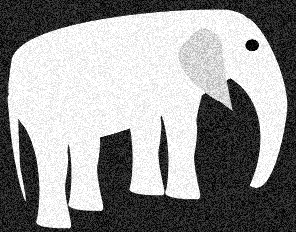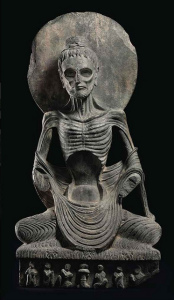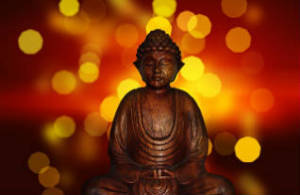How did Siddhartha Gautama become
The Buddha?
For anyone who wants to understand the philosophy of Buddhism it is helpful to learn a bit about the life of the Buddha. While some of the exact details of his life are not known with certainty, it is widely accepted that he lived between 563-483 BCE.
The Buddha was born in Southern Nepal at the foot of the Himalayas. He name was Siddhartha Gautama. He was born the son of a King and was, therefore, a Prince.
Legend says that before Siddhartha was born his mother had a dream. In her dream, a white  elephant offered her a lotus flower and then entered the side of her body (as if to be born from her).
elephant offered her a lotus flower and then entered the side of her body (as if to be born from her).
When sages interpreted the dream, they said that she would give birth to a son. That son would either become a great ruler or he would become a holy man – an enlightened being.
Siddhartha’s mother, the Queen, sadly died 7 days after giving birth. Siddhartha’s father was devastated, but quickly had a stepmother for his son.
The King was disturbed by what the sages said; he did not want his son to become a holy man. He wanted his son to be a great and powerful King and he would do everything he could to make sure that happened.
Siddhartha’s father knew that if his son were to experience or see pain and suffering in the world he would become curious and want to know about it. He feared that this would turn him into a holy man searching for answers in life.
He wanted to make sure Siddhartha had everything he could ever want, but more importantly, he wanted to make sure Siddhartha never saw or experienced pain or suffering within the kingdom.
Siddhartha had all of the luxuries of life that one could imagine. He never left the palace kingdom, as everything he could ever want was there.
The King made sure there were no sick or old people in the kingdom. There would be no dead flowers or dead animals. He wanted there to be nothing but pleasure all of the time. The King believed that if he could shield his son from seeing any bad in the world he would protect him and ensure that he become King.
Siddhartha had luxurious food, dancing girls, 3 lotus ponds (one with red lotuses, one with white, and one with blue), and more. Then, at 16 as per tradition, Siddhartha was married, fell in love and had a child.
He loved is wife very much, but as he grew older he became curious about the world outside the kingdom.
At the age of 29 he went out into the city
Siddhartha’s curiosity about the world outside of the kingdom grew until one day, he asked a guide to take him around the city.
He saw 4 things of importance on his explorations:
- An old man
- A sick man
- A corpse
- A holy man
Siddhartha asked his guide about each of these.
Siddhartha: [about the old man] ‘Why does that man look that way?’
Guide: ‘That is an old man. We will all get old and look like that one day.’
Siddhartha: [about the sick man] ‘What is wrong with that man?’
Guide: ‘That is a sick man; everyone gets sick and feels pain.’
Siddhartha: [about the corpse] ‘What is wrong with that man?’
Guide: ‘He has died. We will all die one day.’
This was the first time Siddhartha had recognized impermanence. His father had sheltered him from these realities in life and Siddhartha was shocked by what he saw. In these things (the old man, the sick man, and the corpse), he saw his own fate, as well as the fate of everything he loved. For the first time, he saw suffering.
Finally, Siddhartha encounters a holy man. He learns that this is a spiritual seeker, one who is trying to find answers, enlightenment, and happiness in a world that is ever changing and seems filled with so much pain and suffering.
These new experiences had a life-changing impact on Siddhartha. He now wanted to understand suffering and see if there was a way to be free from this suffering.
Siddhartha leaves the palace
After this, Siddhartha knew he could no longer stay in the kingdom. He had to find answers to his questions on suffering – Why is there suffering? Can we find cessation from suffering? Siddhartha left the palace and his family and traveled south towards the Ganges River.
During this time in India there were many spiritual seekers. Siddhartha found a guru to follow and learned about yoga and meditation. He became a renunciant – he remained homeless, practiced celibacy and deep meditation.
He was able to experience peaceful and blissful states of being during his meditations, but they never lasted. This sort of practice did not present the truth of the world to Siddhartha; it did not lead to the deeper change and knowledge that he was searching for.
He left his guru, still searching for answers. Why is there suffering? Is there an escape from this suffering?
Asceticism was a popular practice at this time in India (and still practiced today). This is where you abstain from all worldly pleasures to pursue spiritual enlightenment and inner peace.
Siddhartha experienced extreme luxury (in the kingdom), but never found enlightenment. Therefore, he thought he would try the opposite. He practiced extreme asceticism (which includes self-mortification). He would eat only 1 grain of rice each day, subject his body to hardship and pain by sleeping on nails, standing on 1 foot all day, and meditating for nearly all waking hours.
He was very dedicated to his practice, but after 6 years he found himself completely emaciated and dying. His face was sunken in, his ribcage was sticking out, and his arms were like thin tree limbs.
Asceticism was not working
Siddhartha had failed. He did not find the answers to his questions. After all of this time  and dedicated practice, he was not enlightened. And now he was near death.
and dedicated practice, he was not enlightened. And now he was near death.
As he was sitting under a tree, a memory from his childhood came to him.
When he was a boy his father took him to a planting festival. Crop planting ceremonies were popular during this time.
He remembered looking down at the ground and seeing all of the insects and other creatures. He realized how these creatures would be destroyed by the planting that was to take place. He became overwhelmed by sadness.
We exist together and are connected to everything. We must realize the perfection in this connection and always have compassion for all other things.
As Siddhartha was sitting there drifting off into this idea of perfect connection with all other things, a young girl came upon him and saw that he was starving. She simply gave him some rice milk and said, ‘Here, eat’. She saw another being suffering and offered what she could.
Siddhartha decided to eat and in doing so he accepted life, the earth, and everything in it. He accepted the kindness, compassion, and generosity from a stranger and from the world.
The problem was, he still did not have answers to his questions. He followed and trusted gurus; he became ascetic and nearly died, and yet he remained unenlightened.
He knew at that point that in order to find what he was looking for, he would have to look within and trust himself – this was the only thing left to try.
What he needed to do was to sit with himself until he found his answer.
Sitting under the Bodhi tree
Siddhartha sat under a Bodhi tree in a place called Bodh Gaya and decided that he would not leave until he solved his problem and attained enlightenment.
Legend says that while sitting there, he was visited by the demon Mara (also called the Lord of Desire, Lord of Death or Lord of the Senses).
Mara was not happy that Siddhartha was seeking enlightenment. He was afraid that if he woke up (became Enlightened) he would put an end to desire in the world. Mara was there to challenge Siddhartha.
He came with an army of demons. Siddhartha did not move and the weapons that were thrown at him were turned into flowers.
Mara then sent his 3 daughters to seduce Siddhartha, hoping he would fall into desire. Siddhartha did not move.
It is important to note that Siddhartha was not in a trance; he was meditating, but still a part of this world. He was aware of the temptations, but chose not to partake.
Mara was furious and asked Siddhartha who would be able to testify to his enlightenment. Siddhartha reached down and simply touched the earth with his right hand and the earth responded by saying, ‘I am your witness’.
Here we see Siddhartha accepting the earth as it is with all its perfections and imperfections, as well as the earth accepting Siddhartha.
As Siddhartha touches the earth, he realizes this and the perfection of it all. But in addition, he realizes and accepts the earth and the world as it is with its imperfections. Siddhartha now understands and acceptances this reality.
After this, he meditates through the night and has visions of all of his past lives. (In the Buddhist tradition, reincarnation is the idea that we come back as different beings – human and non-human).
In each life our goal is to become more enlightened so that we can reach Nirvana, which is Awakening or Enlightenment. Once we reach this point, we will escape what is called the Cycle of Birth and Rebirth (meaning we will not be reincarnated once we die).
As he sees his past lives flash before him he becomes aware of everything and can see all of the past moments as present. He understands the process of birth and death and his mind is at peace with this understanding and acceptance.
It is at the point that he becomes The Awakened One – The Buddha
What he says is, ‘All beings and I awaken together’.
What the Buddha is saying is that within us all is the capacity to become a Buddha. We can all awaken and become enlightened beings.
In fact, we are already enlightened and we are the only ones holding ourselves back. There is so much bliss and wonder in the world, but we are usually closed off to it.
The gateway to this understanding is all in our mind. Thinking that we are separate from everything and trying to fight and find our way in the universe comes from our own ignorance. This is non-reality.
Change must come from within and it all starts with our mind.
The Buddha went on to teach the Four Noble Truths and the Noble Eightfold Path.
You may have heard or will hear of other variations or other interpretations.
6/16/23
The heart KNOWS what the mind often cannot. The mind is the great saboteur
creating an endless chasm that most choose as Truth. Only through the heart
can one come to ‘know’ what is real . The heart is the only opening through which
to commune with ‘Real Life;’
And in the words of C.S. Lewis: “Real Life has not yet begun!’ So that we continue
forward on the path to Enlightenment….